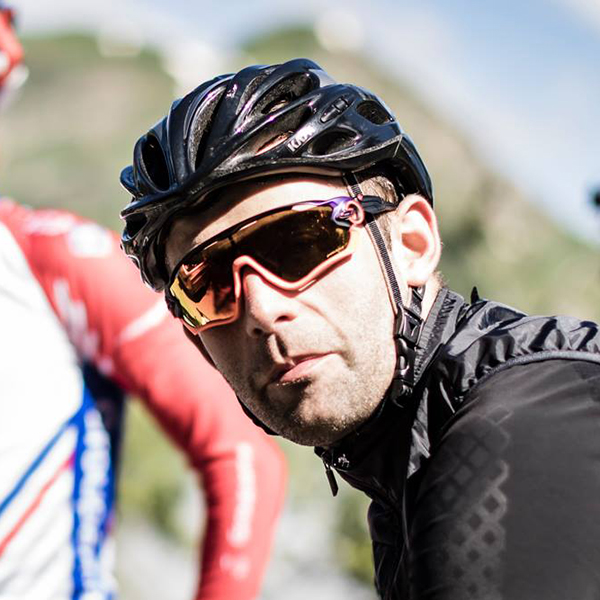Billed as achieving the ‘perfect balance’, the new Canyon Ultimate CFR Di2 blends low weight, high stiffness, aero performance and comfort in one package.
The German direct-to-consumer brand favoured evolution over revolution with the new Ultimate. To the naked eye, one could easily mistake the new frameset for the old one.
Yet, the new bike comes with claims of improvements across the board. In short, you could say it’s set to be the ultimate Ultimate.
My findings? The new Canyon Ultimate CFR is probably the best Ultimate ever made. It’s light, stiff, fast, compliant where it really needs to be, and has a brilliant geometry and forgiving ride position that will enable most riders to maximise their performance.
There are niggles – the Ultimate CFR Di2’s high-spec build doesn’t quite hit an all-round performance sweetspot, while Canyon doesn’t allow you any flexibility in component choices at point of purchase.
But overall, if those niggles don’t bother you, the Ultimate CFR is one of the most impressive all-rounder race bikes available today.
Canyon Ultimate CFR Di2 specs
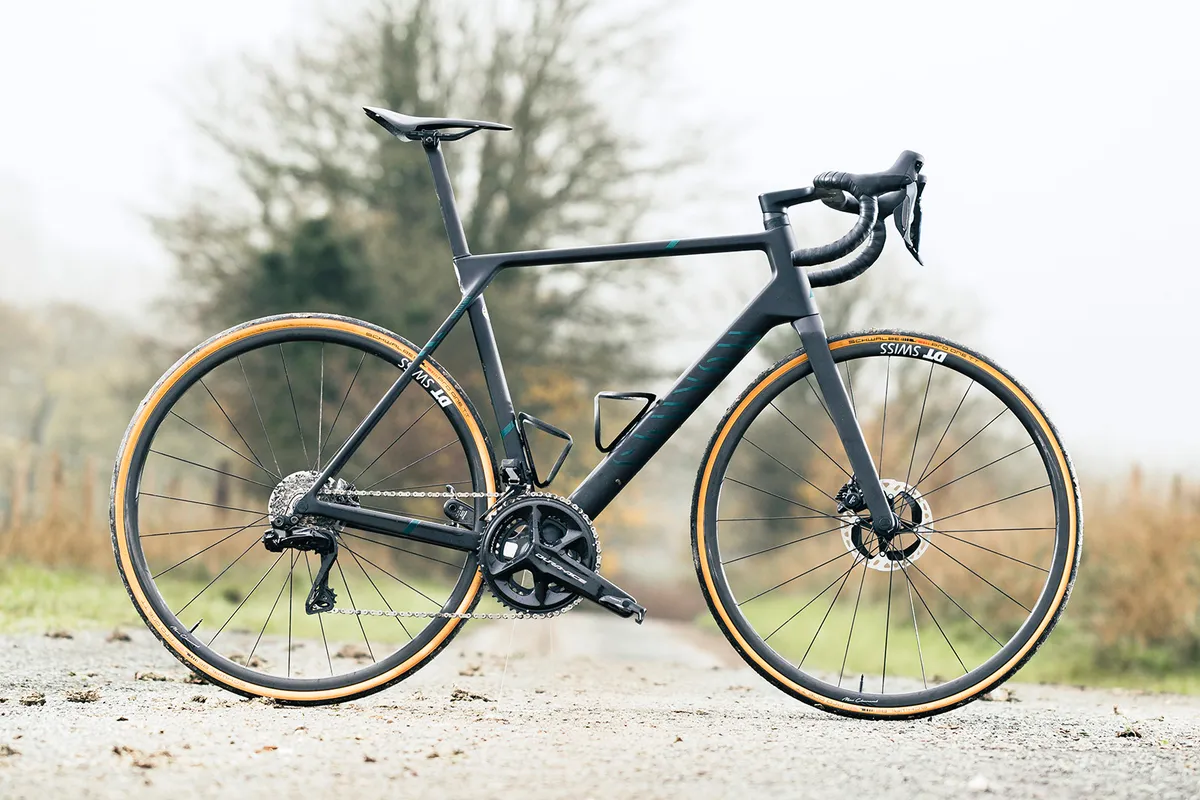
The Canyon Ultimate CFR features the highest-spec carbon of the three offerings in the Ultimate range.
CFR – standing for Canyon Factory Racing – is the lightest of the three, but is said not to lose anything in terms of stiffness or compliance versus the SLX or SL versions of the frame.
The frame and fork weigh a claimed 1,082g together in a size medium. My size-large test bike – the very same machine I rode in Nice, France at the launch in August of this year – tips the scales at 6.39kg.
Without pushing the envelope of what’s technically achievable for a lightweight carbon race bike, the Ultimate CFR Di2 feels almost surreally light in my hands (more on that later).
Visually, this fifth-generation Ultimate is strikingly similar to the previous version. In fact, it’s not dissimilar from the third-generation model (I own a rim-brake version of that bike).
That’s down to Canyon’s stated desire to prioritise evolution over revolution – the brand and its engineers felt that because it already had such a well-rated and popular bike in its arsenal, there was little point making drastic changes just for the sake of it.
In fact, the Ultimate is claimed to still be the cornerstone of the Canyon road bike range, with offshoots including the Aeroad, Endurace and even the Inflite cyclocross bike.
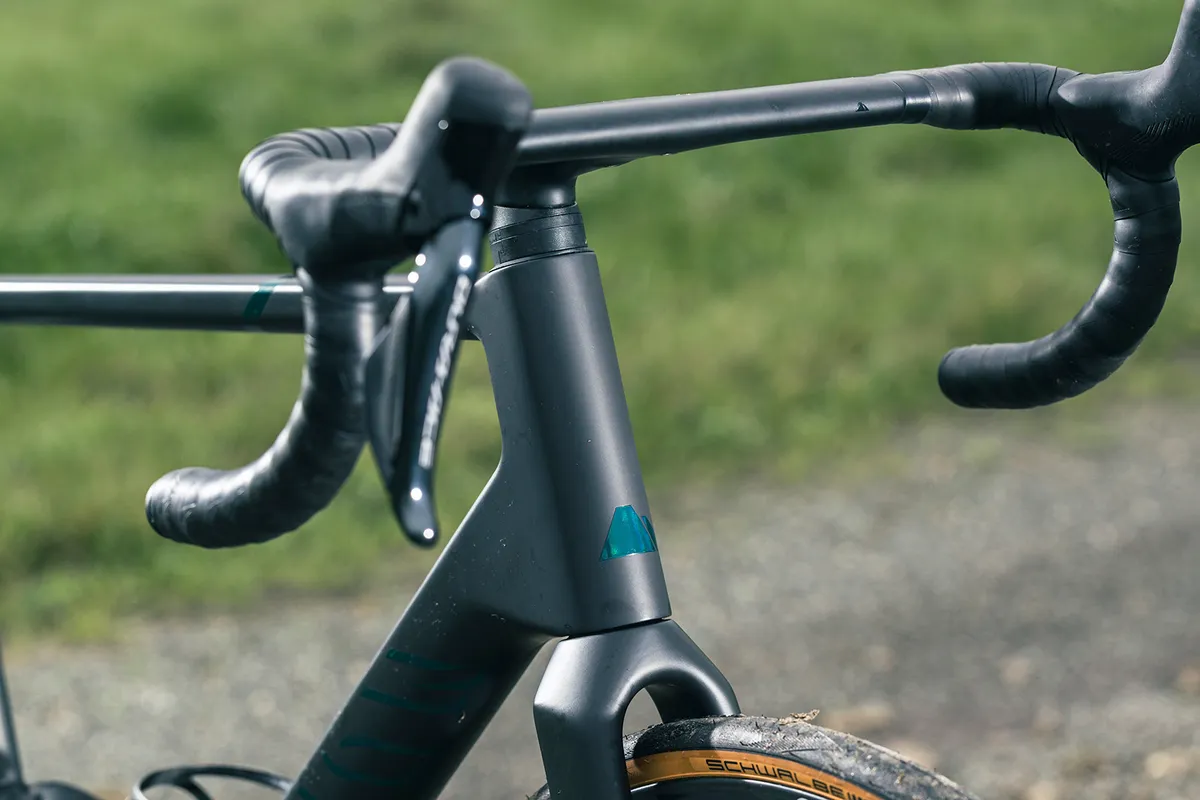
For this latest version, the Ultimate got an aero refresh to the tune of 5 watts at 45km/h, yielding a slightly more angular tubeset with flattened sides.
This also sees the important addition of the proprietary, width-adjustable, integrated bar-stem ‘Aerocockpit’ setup first seen on the Aeroad aero bike.
Cable routing is internal throughout, with hoses routed through the quill-style stem and Acros headset.
Canyon says up to 15mm of jigsaw-like spacers (in 5mm increments) can be added or taken away to adjust stack height, without physically removing the Aerocockpit. Though this limits the amount of stack-height adjustment available, it means there’s no need to cut the steerer for a clean aesthetic.
The German brand also says it has fortified the top tube-seat tube junction, and the bottom bracket area to increase lateral stiffness. The penalty is said to be around 30g compared to the previous model, but Canyon says the side benefit is increased frameset reliability.
The new Ultimate has dropped the traditional 27.2mm rounded seatpost format (and therefore the highly rated VCLS seatposts) in favour of a D-shape post. It’s said to be marginally more aero-efficient.
Tyre clearance is now rated to 32mm-wide rubber, thanks to a squaring of the fork shoulders, raising of the crown and marginally increased spacing around the bottom bracket-chainstay zone.
The bottom bracket sticks to a BB86 press-fit standard.
Canyon Ultimate CFR Di2 geometry
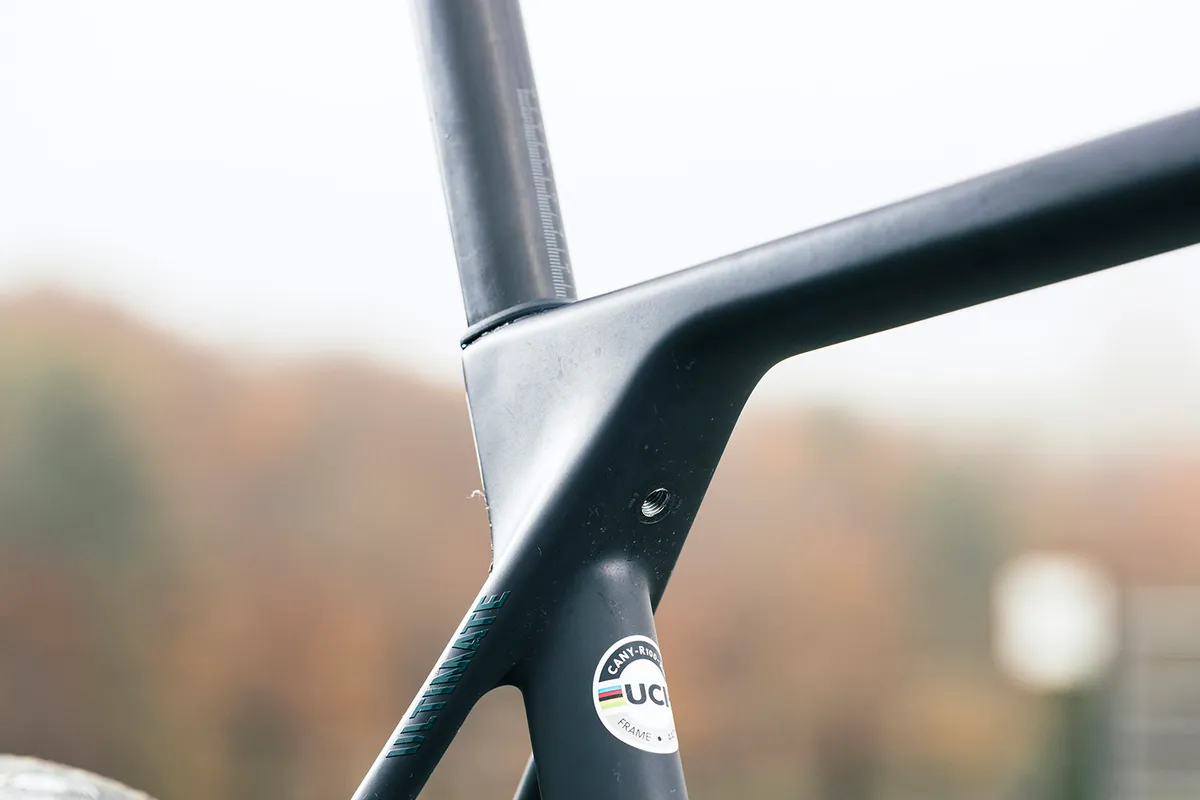
As I reported when the new Ultimate surfaced, the geometry has been tweaked to bring it into line with the Aeroad aero bike.
Although that sounds like a move that could make the Ultimate a little less comfortable to ride, the Aeroad itself is based around the fourth-generation Ultimate’s ‘Sport Pro’ geometry.
As a third-generation Ultimate owner, I can appreciate the extra reach this provides in a size large.
To get broadly the same saddle-hoods measurement (important for me because I have a long back), my old bike has a 120mm stem – here, the 110mm Aerocockpit length suffices.
As I mentioned in my first ride review, the reach measures 401mm, plus the 110mm stem length. By comparison, a 56cm (size-large equivalent) Trek Madone SLR is 391mm, with a 100mm stem.
In terms of stack height, 580mm straddles the middle ground between being aggressively low and forgiving. It’s still aggressive, but not prohibitively so.
Despite the length and stack, the Ultimate still prioritises sharp handling. So chainstay lengths have shortened in a sliding scale, depending on the frame size, to keep behaviour consistent.
My large frame features 413mm chainstays.
The sliding scale approach to geometry continues with the head tube angle. The frame here sees a steep 73.25 degrees, right in classic road race bike territory.
In this size, the 1,003mm wheelbase is intended to keep the Ultimate lively and responsive, but predictable.
In short, Canyon wants the Ultimate to be equally capable of taking on fast and technical road routes and being a companion for long days in the saddle.
| | XXS | XS | S | M | L | XL | XXL |
|---|---|---|---|---|---|---|---|
| Seat angle (degrees) | 73.5 | 73.5 | 73.5 | 73.5 | 73.5 | 73.5 | 73.5 |
| Head angle (degrees) | 71.5 | 71.2 | 72.75 | 73.25 | 73.25 | 73.5 | 73.75 |
| Chainstay (mm) | 405 | 410 | 410 | 410 | 413 | 415 | 415 |
| Seat tube (mm) | 420 | 450 | 480 | 510 | 540 | 570 | 600 |
| Top tube (mm) | 524 | 537 | 554 | 564 | 577 | 603 | 619 |
| Head tube (mm) | 115 | 107 | 121 | 142 | 162 | 188 | 206 |
| Wheelbase (mm) | 965 | 979 | 982 | 988 | 1,003 | 1,029 | 1,042 |
| Stack (mm) | 501 | 523 | 542 | 563 | 583 | 609 | 627 |
| Reach (mm) | 372 | 378 | 390 | 393 | 401 | 419 | 429 |
| STR | 1.35 | 1.38 | 1.39 | 1.43 | 1.46 | 1.45 | 1.46 |
| Spacers (mm) | 15 | 15 | 15 | 15 | 15 | 15 | 15 |
| Stem (mm) | 80 | 90 | 90 | 100 | 110 | 110 | 120 |
| Handlebar width (mm) | 390 +/- 20 | 390 +/- 20 | 390 +/- 20 | 410 +/- 20 | 410 +/- 20 | 410 +/- 20 | 410 +/- 20 |
| Crank arm length (mm) | 170 | 170 | 172.5 | 172.5 | 175 | 175 | 175 |
| Seatpost length (mm) | 316 | 316 | 316 | 316 | 316 | 316 | 316 |
| Wheel size (mm) | 700c | 700c | 700c | 700c | 700c | 700c | 700c |
Canyon Ultimate CFR Di2 performance
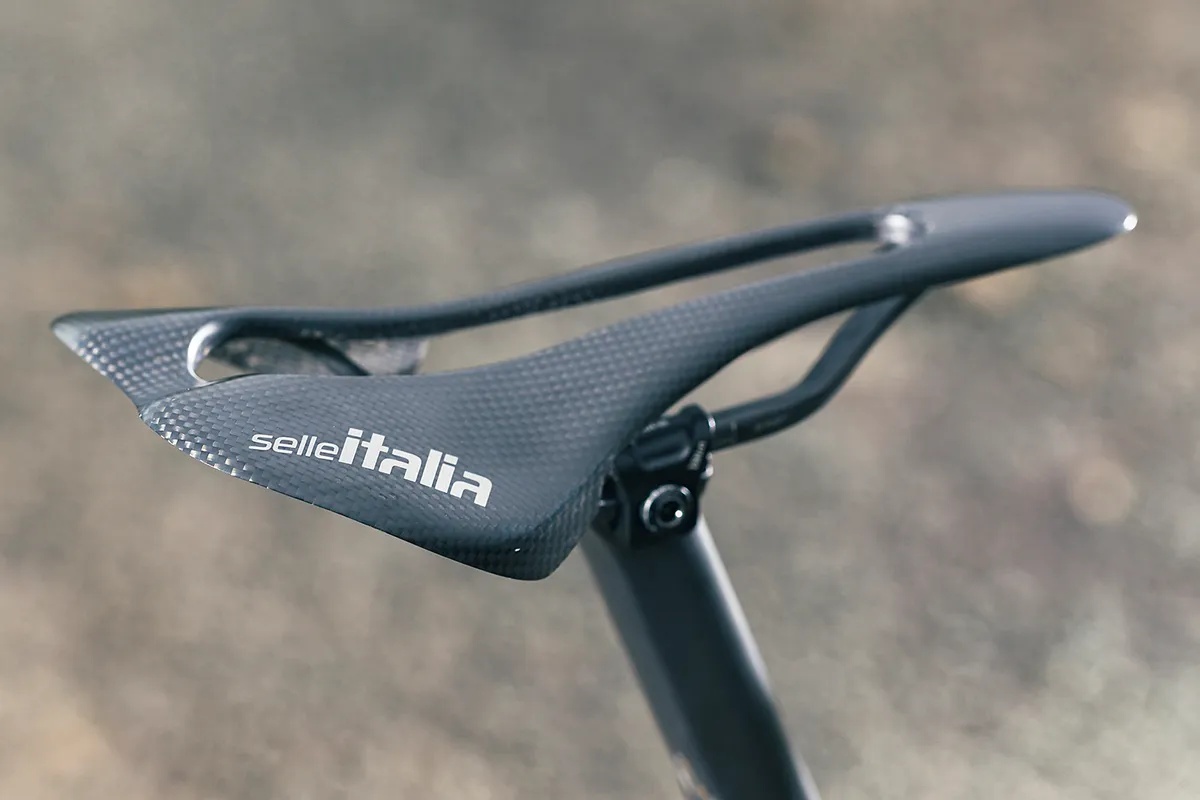
Overall – with the benefit of having ridden the previous two generations of the Canyon Ultimate – the latest CFR feels like a kind of evolutionary victor.
The frame retains the excellent stiffness of its forebears, which translates into an incredibly fun, almost addictive ride.
The top-spec build here plays its part (more on that later), but the Ultimate CFR certainly has a little sparkle within it despite its classic, some-might-say-dull, looks.
The ride position and geometry is outstanding, delivering an experience that is incredibly involved, yet not to the point that it ever becomes tiring.
Although it’s a very light bike at 6.39kg, it doesn’t feel too light.
In my experience, the lightest and stiffest bike frames can occasionally feel disconcerting because they lack the ride quality, compliance or assuredness a slightly beefier construction can bring. Canyon seems to have got the balance spot on here, though.
Maybe that’s down to the 30g of strengthening put into key areas of the frame, or the not-too-aggressive geometry. In truth, it’s more likely a combination of the two.
For short, high-intensity rides, the Ultimate CFR is insatiable and laps up all you’ve got and more, while it takes care of you on longer rides as fatigue sets in.
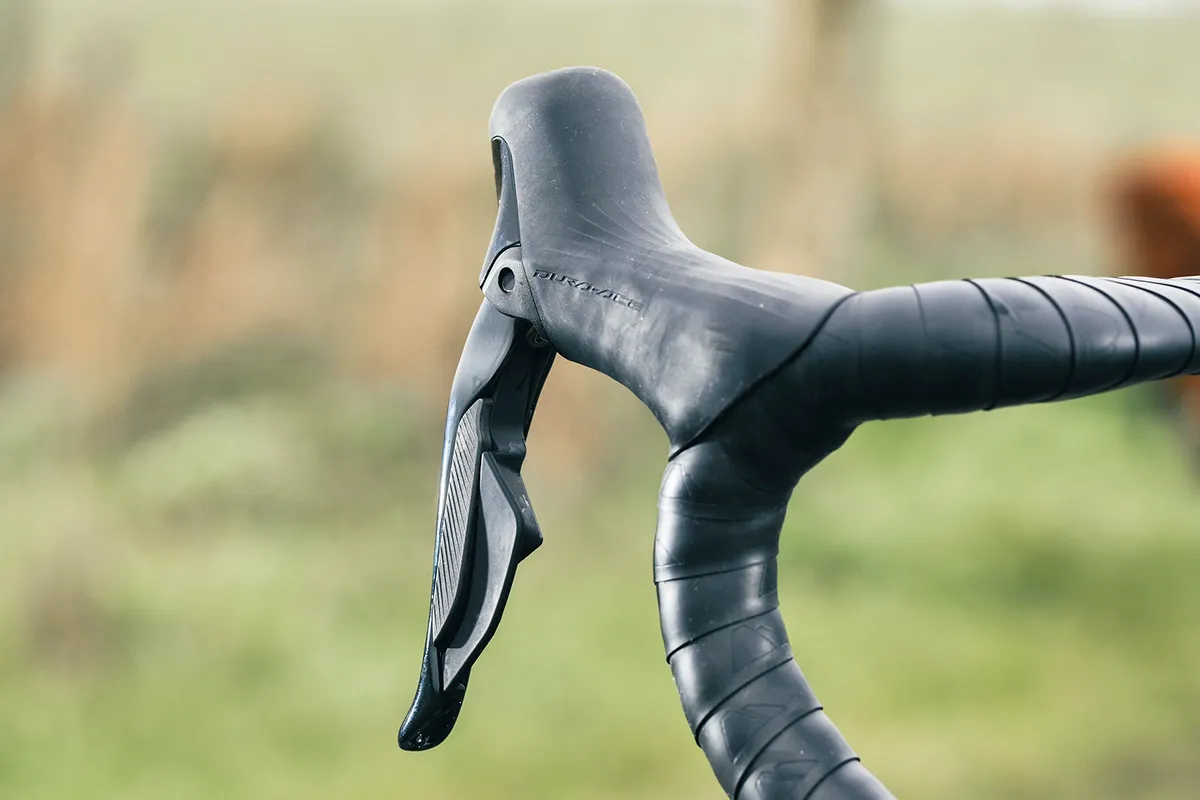
On the road, steering is sharp with pinpoint accuracy. Tackling challenging descents, the Ultimate CFR feels informative and confidence-inspiring, especially through the front end.
Having more precisely adjusted the fit at home following the launch (with knowledge gleaned from a recent bike fit), I felt well connected with the front wheel and got bags of feedback in response to my inputs.
The short chainstays ensure the rear of the bike feels equally taut and quick to respond.
Out of the saddle, the Ultimate CFR whips left and right with consummate ease. As you might expect, this pays dividends when climbing.
The longest climbs I’ve ridden on this bike were covered in the south of France. There, it impressed me as a bike I could sit in the saddle and tap out a rhythm on.
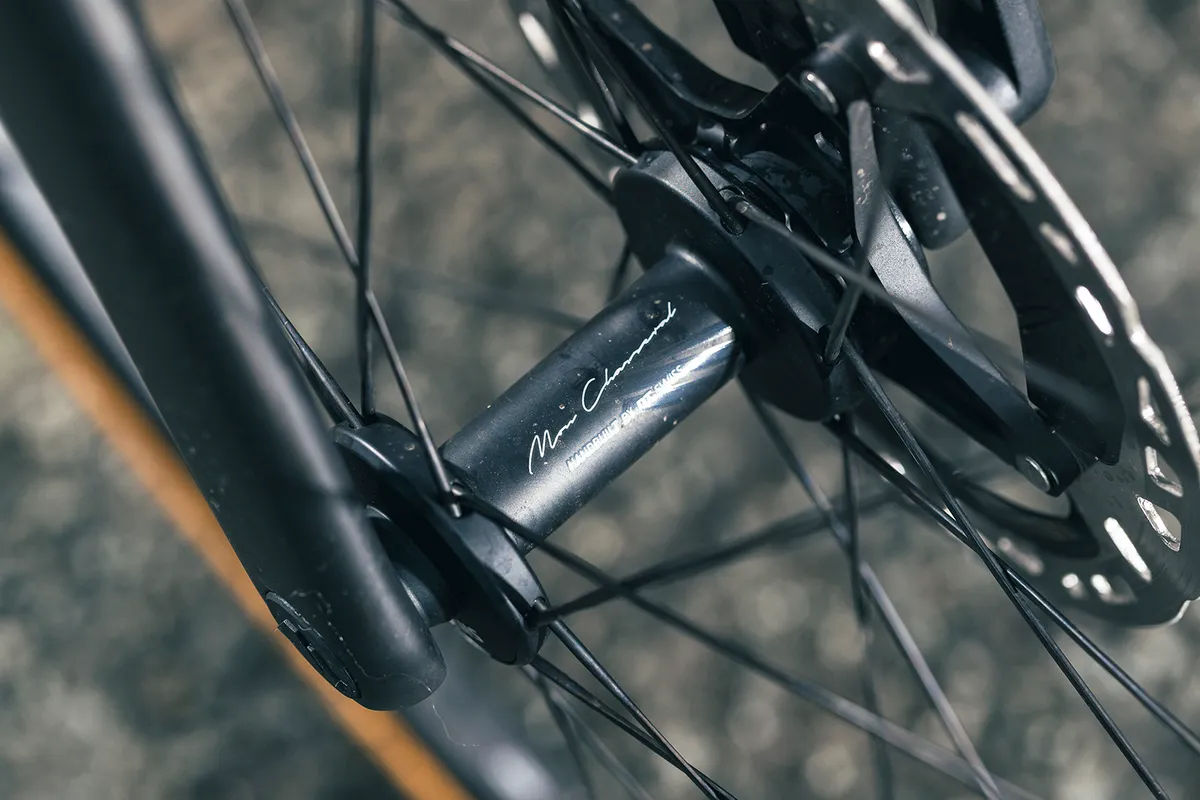
That feeling remains here in the UK, where hills are far shorter and (often) steeper. Yet, here you can really attack shorter hills and derive great satisfaction from the sense of efficiency beneath you.
I’m a rider who likes to set a seated Tom Dumoulin-esque rhythm (albeit at a far more modest power-to-weight ratio) regardless of the hill I’m faced with. On the Ultimate CFR, I found myself getting out of the saddle and attacking climbs with much more frequency, and enjoying it.
I’ve not set any key Strava personal records with the CFR, but I’ve come close a few times – enough to demonstrate the bike’s sheer speed on ascents.
The very light and stiff DT Swiss wheelset plays an important role here, but swapping temporarily to a set of deeper and heavier Hunt Limitless 48 UD hoops (with 28mm Continental GP5000 S TR tyres) didn’t drastically reduce climbing performance overall.
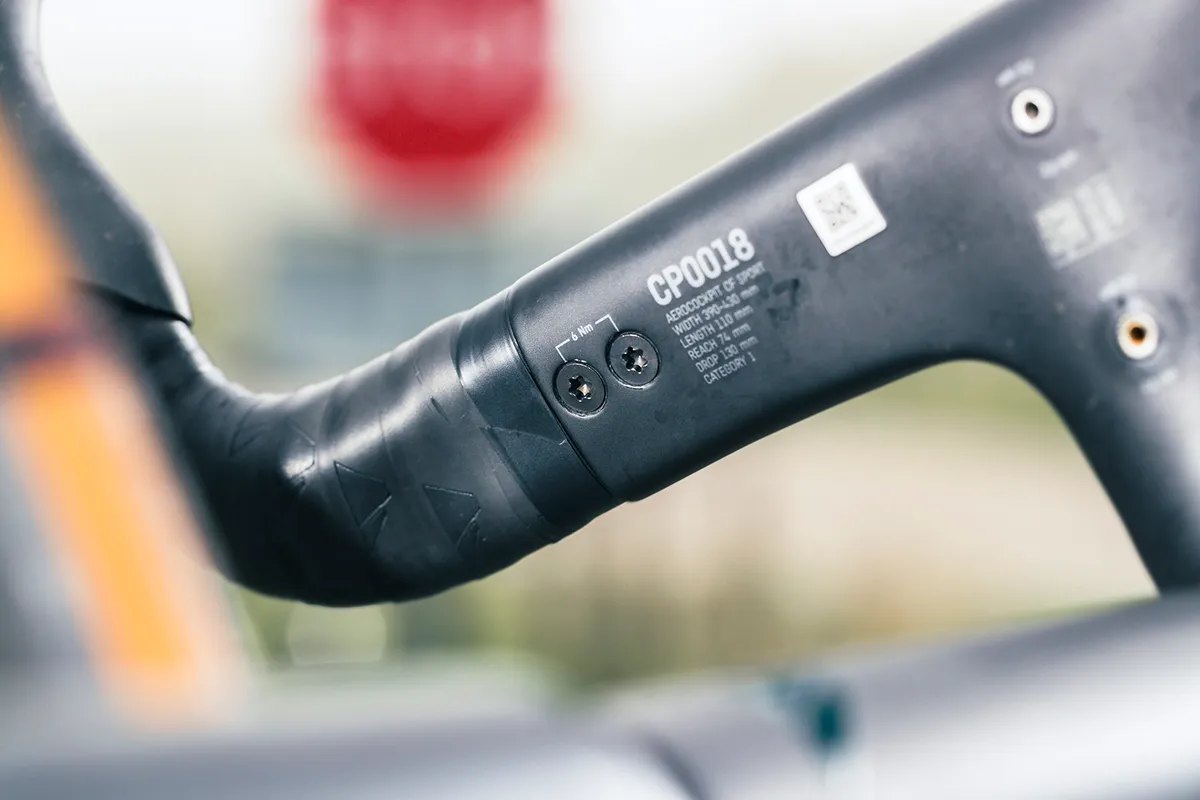
On the flat, the Ultimate CFR Di2 makes progress with ease anywhere up to around 35 to 40kph. Beyond that, it's left a little wanting versus a more aero-optimised system.
The shallow wheelset in this build certainly doesn’t help matters, with the deeper-section Hunts feeling faster on flat rides.
However, if speed on mixed and flatter topography is your primary concern above all else, there’s a strong argument to be had that a more aero-optimised frame would serve you better.
As it is, I’m generally happy to sacrifice a little flat performance for a more fun and efficient-feeling ride on steeper climbs, as well as a more comfortable experience over the course of a long day in the saddle.
The UK roads I test bikes on can also easily expose any shortcomings when it comes to comfort.
I would argue the wheel and tyre setup here is geared more towards delivering stiffness and acceleration to overcome moments of low inertia, but despite this there’s no excess road buzz.
Poor, potholed tarmac can feel a touch juddery to traverse at times, but the wheel-tyre system as specified doesn’t do the bike any favours here. Swapping to wider rims and a higher-volume front tyre more or less solves this.
All-in, the Ultimate CFR Di2 is a brilliant all-rounder and as great for shorter, high-intensity sessions as it is on longer rides. However, the build can feel a little too specialised for the ‘real world’.
Canyon Ultimate CFR Di2 finishing kit
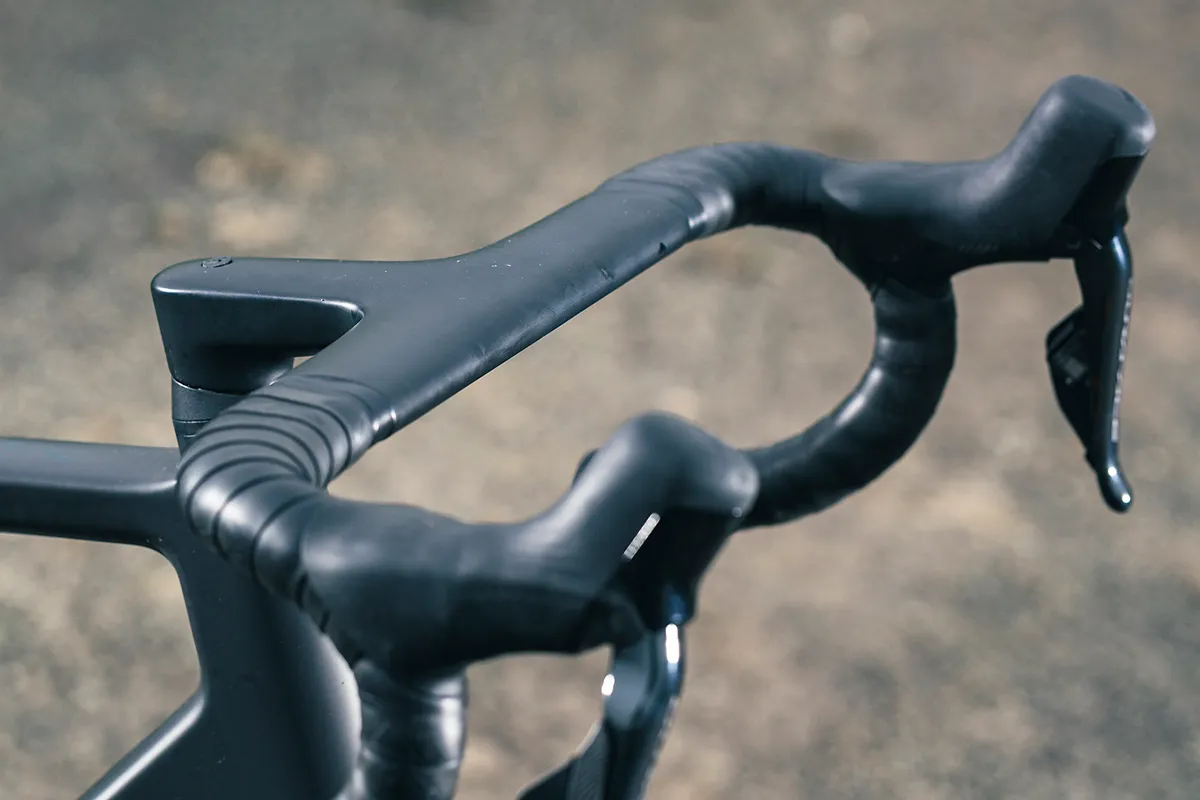
As is par for the course with Canyon bikes, the finishing kit comes largely from the German brand too.
Notably, the front end receives the carbon CP0018 Aerocockpit, complete with built-in width adjustment.
A large-sized bike is specced with a 41cm-wide model, which can be narrowed or widened using the adjustment screw mechanism on the underside of the tops by up to 20mm on either side.
You’ll need to do a little re-taping if you change it from the default, so this isn’t a system necessarily designed for constant changing. Instead, I think Canyon intends you to settle on your optimum measurements then leave them there.
The drops are shaped well, making riding in them relatively comfortable. Transitioning between drops and hoods is easy too.
As with practically all integrated handlebars, though, there’s no scope to adjust the stem length without swapping out the entire thing.
The seatpost style has also changed. Out goes the traditional round 27.2mm post, and in comes a D-shaped model.
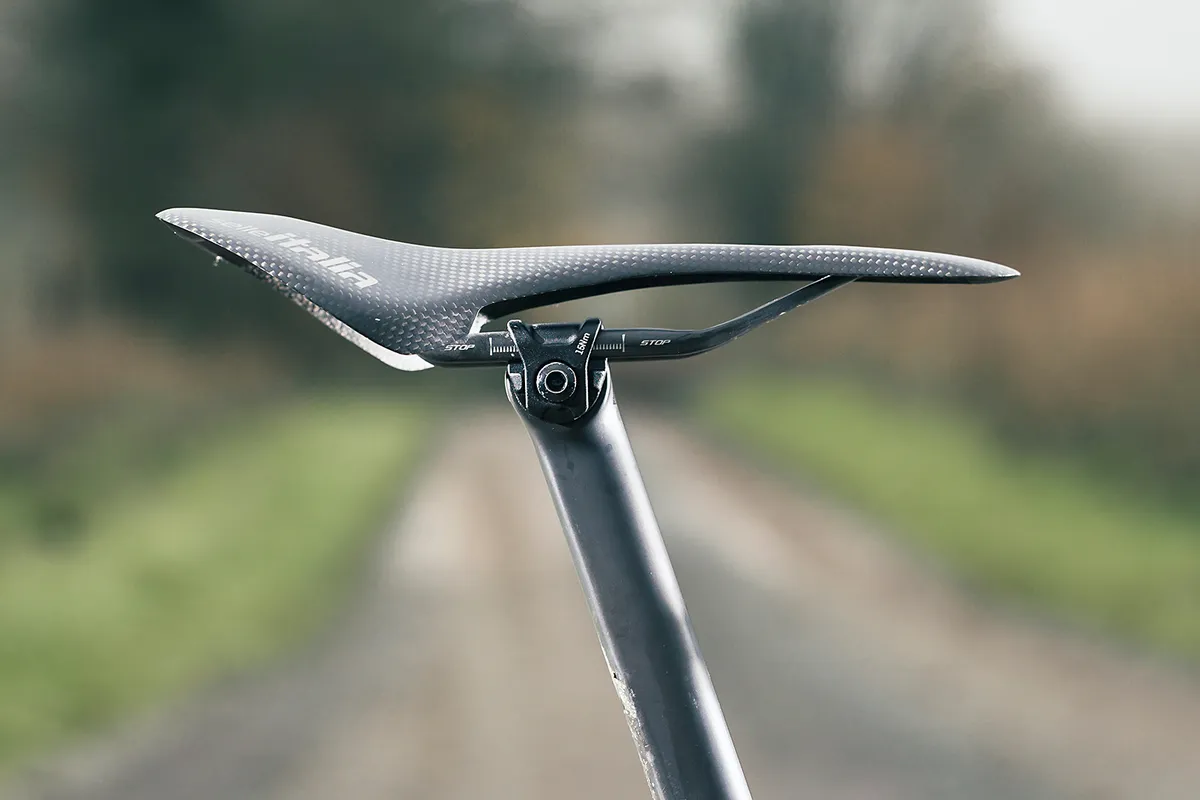
Fans of VCLS seatposts gone by may lament their passing, but the D-shape replacement has by no means been a cause for concern. In fact, I’ve been impressed by the comfort, in general.
Naturally, the proprietary shape means Canyon is restricting you in terms of swapping it for something else.
The CFR comes specced with an inline post, weighing just 70g, but the brand offers a 10mm setback version separately should you need it.
Sadly, should you want the setback version for fit purposes, you have to choose between ‘lowering’ your gaze to the Ultimate SLX builds, which include it as stock, or stumping up the cash for the additional post. Canyon doesn’t offer the ability to swap components at point of purchase.
The perch is a Selle Italia SLR C59 model. It’s almost as light as they come, weighing a scant (claimed) 61g.
On the smooth roads of the Côte d’Azur, I found it was shaped comfortably despite its non-padded construction, complete with cut-out.
Further testing in the UK highlighted an emerging (and understandable) desire for at least some padding from my saddle, prevailing road surfaces being what they are.
Of course, saddles are a personal choice – if you get on with the shape and don’t struggle with poor tarmac where you ride, it’s a fine choice in-keeping with the lightweight build of the bike.
If I owned the bike myself, I’d be tempted to switch it for something a little less ‘raw’.
Canyon Ultimate CFR Di2 groupset, wheels and tyres
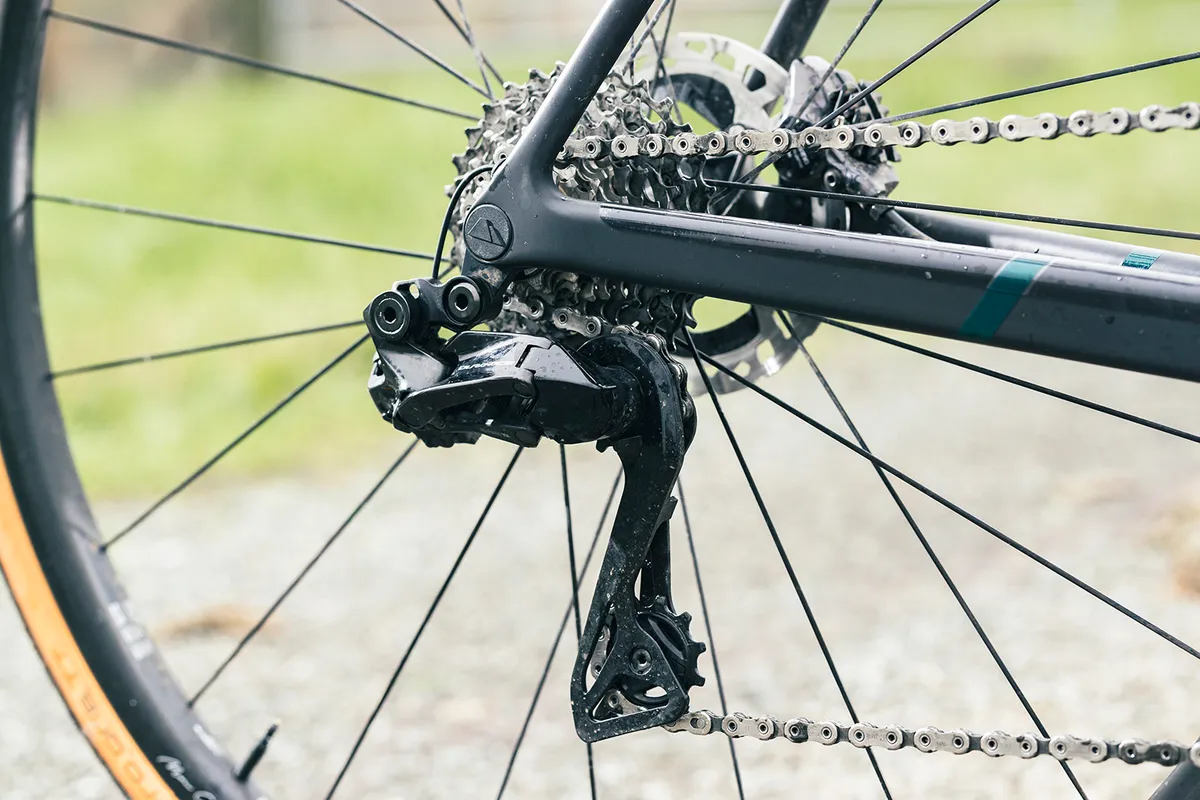
The Shimano Dura-Ace R9170 Di2 groupset is practically perfect for the CFR, especially if you consider system weight a priority.
An Ultegra R8170 Di2 groupset would likely offer precisely the same shifting and braking performance, but for that you need to drop to the SLX frame.
Here, you get the full benefit of the updates Shimano brought to Dura-Ace in 2021, including the excellent Shimano XTR RT-MT900 rotors.
With the benefit of BikeRadar’s accumulated experience riding different Dura-Ace Di2-equipped bikes, the XTR rotors are more resistant to warping under load.
Shimano has since launched updated RT-CL900 rotors for Dura-Ace. The inclusion of them is not always a given on full-build bikes across the industry at the moment, but frankly the Ultimate CFR Di2 doesn’t suffer for it.
Customers will also get the Dura-Ace-spec power meter, although eagle-eyed readers will note it’s missing from my test build. This is owing to a lack of availability at time of build.
The bike comes specced with 52/36t chainrings and 11-30t cassette. For me, that’s a spot-on match and I’m glad Canyon hasn’t defaulted to assuming that only the very strongest bike riders would buy the CFR and fit the new 54/42t model crankset.
The wheelset (and tyre choice) has left me polarised.
The hoops are DT Swiss PRC 1100 Dicut Mon Chasserals. They’re incredibly light at a claimed 1,266g for a set, and feature a 180 Racthet EXP hub, complete with SINC ceramic bearings.
They’re 24mm deep, with an 18mm internal width.
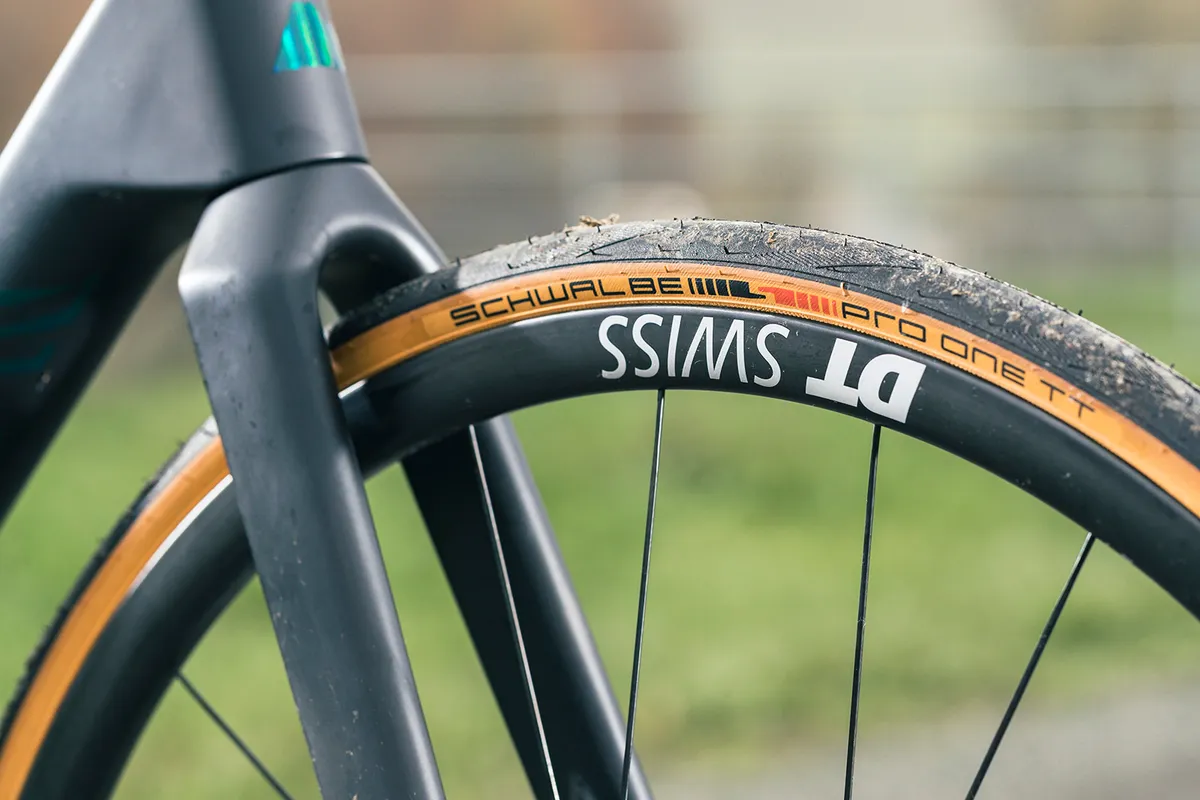
Meanwhile, the tyres are Schwalbe Pro One TTs, 25c front and 28c rear. These are said to be the fastest tyres Schwalbe makes, with a Super Race carcass and Addix Race compound.
Importantly for most riders, they lack much in the way of puncture protection, and Schwalbe doesn’t claim them to be particularly long-lived either.
If your main concern is going fast in the mountains, it’s weapons-grade stuff from Canyon to pair these two together.
I loved riding them up the Col d’Eze and Col de la Madone. The wheels’ freehub ratchets engage incredibly quickly, while the lack of mass helps you easily overcome low inertia.
The tyres especially grip superbly when cornering, and feel very supple.
But assuming you’ll also want to ride the Ultimate CFR in less-than-perfect conditions (without having spare rolling stock ready to swap to), the setup isn’t ideal.
Even if you do have alternative wheels and tyres to swap to, you need to factor in the cost and the impact that swap will have on the overall ride experience.
For the avoidance of doubt, the wheel and tyre combination as specified is stunningly good, and feels amazing to ride in the right conditions.
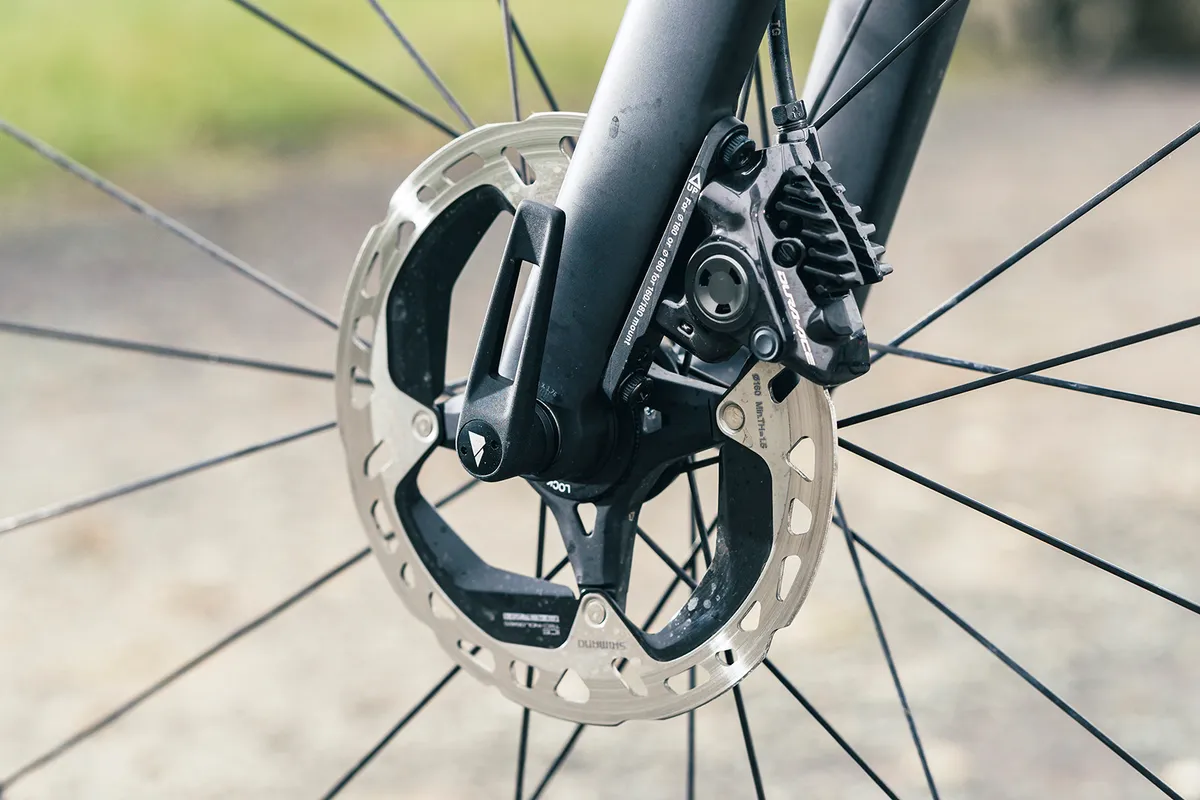
However, the lack of aero performance from the wheels I can feel at faster speeds, and especially the potential fragility of the tyres – plus the narrow front-tyre width – means there is likely a better combination out there for many riders.
On paper, I’d be tempted to consider the Ultimate CFR Disc Aero as a better all-round build (although you still get the same tyres), with DT Swiss ARC 1100 wheels.
With that model, there’s a small weight penalty of around 250g, and – importantly for some – there’s no power meter. That said, you could use the £2,000 saving and buy one.
You could also opt for the Ultimate SLX 9 Di2 if you want Shimano’s top-spec groupset, but don’t mind stepping down a grade of carbon and sacrificing around 370g.
Canyon Ultimate CFR Di2 bottom line
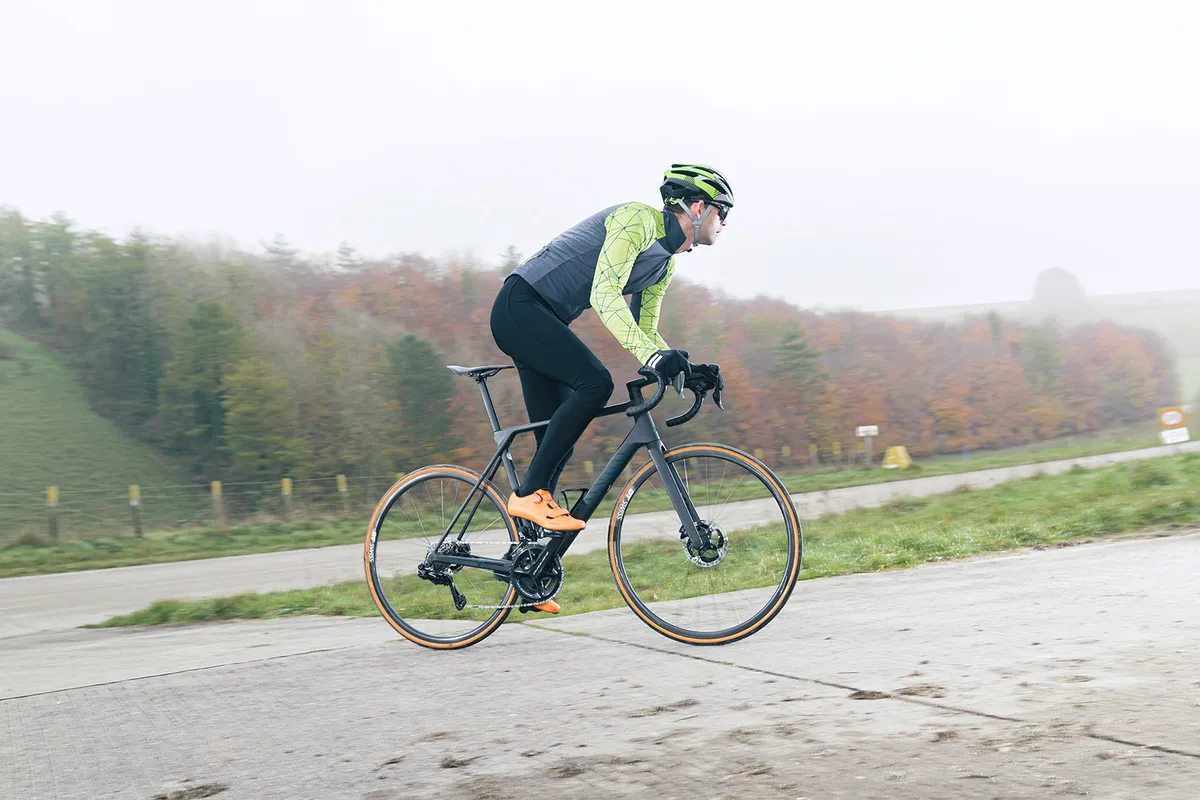
The Ultimate CFR is a brilliant all-round performer. Canyon has done a fantastic job of preserving all that was good about previous Ultimates, while looking to improve the formula where possible.
The bike handles incredibly well. It’s informative and tactile, and the well-considered geometry and ride position mean I would happily jump on the Ultimate CFR and ride it again and again. Despite its exceptionally light weight, the frame doesn’t sacrifice compliance or ride quality.
The aero tweaks to the frameset and cockpit also help keep the Ultimate CFR competitive with the latest crop of all-rounder road race bikes, without muddying its identity.
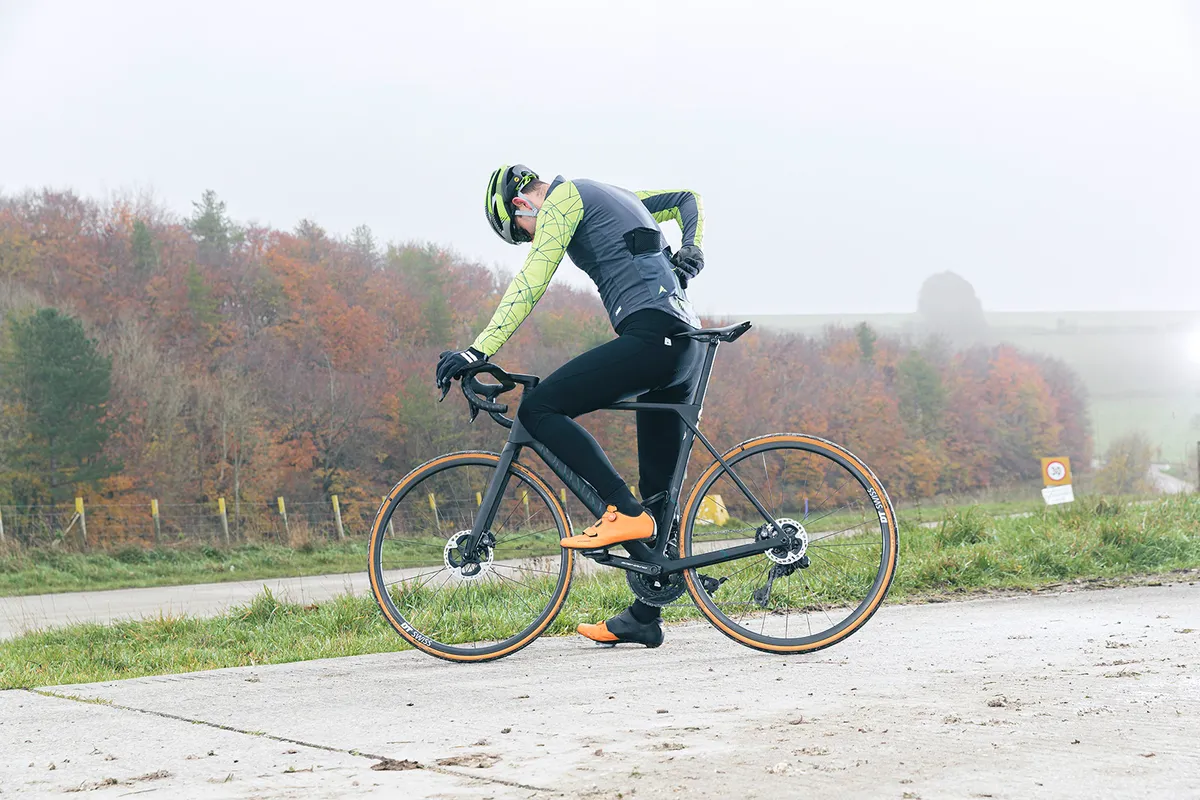
The CFR Di2 specifically is not flawless, however. Its build – though exciting and fun to ride – is arguably too focused on excelling in the mountains to be a one-stop shop superbike purchase for a real-world customer.
That’s a shame. At its heart, the Ultimate CFR Di2 is an outstanding all-round road bike that will deliver fun in spades – but in this specification, it just misses being the very best.
Product
| Brand | canyon |
| Price | 15349.00 AUD,10499.00 EUR,10399.00 GBP,10900.00 USD |
| Weight | 6.3000, KILOGRAM (L) - |
Features
| Fork | Canyon Ultimate CFR |
| br_stem | Canyon CP0018 Aerocockpit |
| br_chain | Shimano Dura-Ace 12spd |
| br_frame | Canyon Ultimate CFR |
| Tyres | Schwalbe Pro One TT, tubeless-ready (set up clincher), 25mm front / 28mm rear |
| br_brakes | Shimano Dura-Ace R9270 hydraulic disc |
| br_cranks | Shimano Dura-Ace R9200 52/36t 12×2 |
| br_saddle | Selle Italia C59 Carbon |
| br_wheels | DT Swiss PRC 1100 Mon Chasseral |
| br_shifter | Shimano Dura-Ace Di2 R9270 |
| br_cassette | Shimano Dura-Ace R9200 12×2, 11-30t |
| br_seatpost | Canyon SP0064 (zero setback / inline) |
| br_handlebar | Canyon CP0018 Aerocockpit |
| br_availableSizes | 2XS. XS, S, M, L, XL, 2XL |
| br_rearDerailleur | Shimano Dura-Ace Di2 R9270 12×2 |
